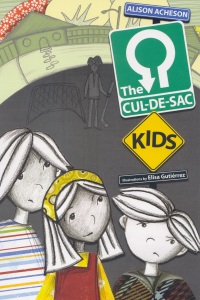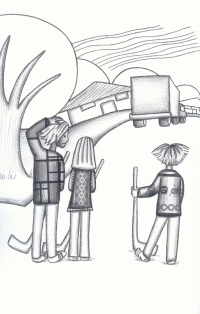| ________________
CM . . .
. Volume XVIII Number 41. . . .June 22, 2012 
 |
The Cul-de-Sac Kids.
Alison Acheson. Illustrated by Elisa Gutiérrez.
Vancouver, BC: Tradewind Books, 2012.
88 pp., trade pbk., $8.95.
ISBN 978-1-896580-99-9.
Grades 2-4 / Ages 7-9.
Review by Karen Rankin.
**½ /4
|
| |
|

excerpt:
The day after [he first arrived at his new home], when Mr. McNeil drove up, Jed held out his old hockey stick.
“I bet you don’t play hockey,” said Jed.
Mr. McNeil looked startled. “You’re right. I used to play baseball.” He didn’t take the hockey stick.
Patrick cleared his throat as if he was going to say something. Something important.
“Yes?” said Mr. McNeil.
“Kids!” Patrick finally said. “Do you have any kids? Even just one?”
“No,” said Mr. McNeil.
“That’s too bad,” said Patrick.
“We need a hockey player,” said Jed.
“Noli was our goalie,” said Kezie.
Mr. McNeil scratched his head. “I will be getting two kids soon – Henry and Daisy. Henry’s about your age, Daisy is younger.” Then he hurried into the house.
Jed felt as if a cloud had dropped a load of hot dogs on his head. “Huh?” he said. “How do you get two kids soon? How does that work?”
Patrick and Kezie stared after Mr. McNeil and shook their heads. They didn’t know.
“Do you hear any rattling?” whispered Jed.
“None,” said Patrick.
Kezie whispered too. “I hear a bit.”
Patrick tried hard but couldn’t hear anything. “Maybe this will all work out,” he said. But Jed and Kezie shook their heads.
Patrick, Kezie, and Jed like playing ball hockey and are not happy when Noli, their goaltender, moves away from the cul-de-sac. They are even more upset when they meet Mr. McNeil, the new person living in Noli’s house: he has no children and doesn’t seem to like hockey. He agrees to play goalie once but proves to be a dismal failure. Plus, unlike Noli’s Mom, Mr. McNeil does not bake cookies. However, it turns out that he’s about to marry a woman with two children. The children come for a visit before moving in and let the cul-de-sac kids know they think Mr. McNeil is great. Patrick, Kezie, and Jed are sure Henry and Daisy will be disappointed with their new dad. Consequently, they try to teach him to play goalie and encourage him to bake cookies, build something, and think about more of their own concerns, such as the number of chairs at his kitchen table. (There should be enough for their visits.) They keep an on-going report card on his progress, and by the time Henry and Daisy have moved into Mr. McNeil’s house, most of his marks are either ‘C’ or ‘F.’ But, as they get to know Mr. McNeil better, Patrick, Kezie, and Jed learn why Daisy and Henry think their new dad is great. Mr. McNeil is able to comfort Daisy when she hurts her foot and Henry when he doesn’t make it onto the hockey team he’d hoped for. By the end of The Cul-de-Sac Kids, Patrick, Kezie and Jed have also realized that Mr. McNeil will be a great dad.
 The Cul-de-Sac Kids is well written and moves along at a good pace so that it was not until the end of this approximately 5,000-word story that this reader realized there were lessons for everyone, but little else. For parents reading the story to children, the lesson is that their love, empathy, and support are what really matter in child rearing. For children, the lessons include don’t be too quick to judge and don’t sweat the little stuff. Mr. McNeil is the most developed – and, therefore, credible and engaging character in the story. The kids, though briefly sketched, are believable – as kids in general. Readers never learn their exact ages: they’re old enough to decide that Mr. McNeil “doesn’t have a clue” how to be a good dad and to tell him that he needs their help, and they are young enough to take comments like “rattle around [while on his own] in that big house” literally. In fact, readers don’t learn much about the kids beyond which snack their parents can be counted on to supply and their well-intentioned, but persistent, desire to improve Mr. McNeil’s performance. While illustrator Gutierréz’s simple black and white sketches work well, The Cul-de-Sac Kids would have benefited from more ‘colour’ in the writing. Additional character, plot, and setting details would have drawn this reader further into the story. The Cul-de-Sac Kids is well written and moves along at a good pace so that it was not until the end of this approximately 5,000-word story that this reader realized there were lessons for everyone, but little else. For parents reading the story to children, the lesson is that their love, empathy, and support are what really matter in child rearing. For children, the lessons include don’t be too quick to judge and don’t sweat the little stuff. Mr. McNeil is the most developed – and, therefore, credible and engaging character in the story. The kids, though briefly sketched, are believable – as kids in general. Readers never learn their exact ages: they’re old enough to decide that Mr. McNeil “doesn’t have a clue” how to be a good dad and to tell him that he needs their help, and they are young enough to take comments like “rattle around [while on his own] in that big house” literally. In fact, readers don’t learn much about the kids beyond which snack their parents can be counted on to supply and their well-intentioned, but persistent, desire to improve Mr. McNeil’s performance. While illustrator Gutierréz’s simple black and white sketches work well, The Cul-de-Sac Kids would have benefited from more ‘colour’ in the writing. Additional character, plot, and setting details would have drawn this reader further into the story.
Recommended with reservations.
Karen Rankin is a Toronto, ON, teacher and writer of children’s stories.

To comment
on this title or this review, send mail to cm@umanitoba.ca.
Copyright © the Manitoba Library Association. Reproduction for personal
use is permitted only if this copyright notice is maintained. Any
other reproduction is prohibited without permission.
NEXT REVIEW |
TABLE OF CONTENTS FOR THIS ISSUE
- June 22, 2012.
AUTHORS |
TITLES |
MEDIA REVIEWS |
PROFILES |
BACK ISSUES |
SEARCH |
CMARCHIVE |
HOME |

 The Cul-de-Sac Kids is well written and moves along at a good pace so that it was not until the end of this approximately 5,000-word story that this reader realized there were lessons for everyone, but little else. For parents reading the story to children, the lesson is that their love, empathy, and support are what really matter in child rearing. For children, the lessons include don’t be too quick to judge and don’t sweat the little stuff. Mr. McNeil is the most developed – and, therefore, credible and engaging character in the story. The kids, though briefly sketched, are believable – as kids in general. Readers never learn their exact ages: they’re old enough to decide that Mr. McNeil “doesn’t have a clue” how to be a good dad and to tell him that he needs their help, and they are young enough to take comments like “rattle around [while on his own] in that big house” literally. In fact, readers don’t learn much about the kids beyond which snack their parents can be counted on to supply and their well-intentioned, but persistent, desire to improve Mr. McNeil’s performance. While illustrator Gutierréz’s simple black and white sketches work well, The Cul-de-Sac Kids would have benefited from more ‘colour’ in the writing. Additional character, plot, and setting details would have drawn this reader further into the story.
The Cul-de-Sac Kids is well written and moves along at a good pace so that it was not until the end of this approximately 5,000-word story that this reader realized there were lessons for everyone, but little else. For parents reading the story to children, the lesson is that their love, empathy, and support are what really matter in child rearing. For children, the lessons include don’t be too quick to judge and don’t sweat the little stuff. Mr. McNeil is the most developed – and, therefore, credible and engaging character in the story. The kids, though briefly sketched, are believable – as kids in general. Readers never learn their exact ages: they’re old enough to decide that Mr. McNeil “doesn’t have a clue” how to be a good dad and to tell him that he needs their help, and they are young enough to take comments like “rattle around [while on his own] in that big house” literally. In fact, readers don’t learn much about the kids beyond which snack their parents can be counted on to supply and their well-intentioned, but persistent, desire to improve Mr. McNeil’s performance. While illustrator Gutierréz’s simple black and white sketches work well, The Cul-de-Sac Kids would have benefited from more ‘colour’ in the writing. Additional character, plot, and setting details would have drawn this reader further into the story.